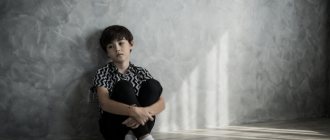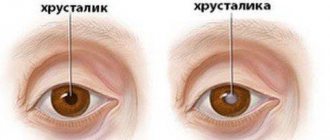What are the features of development, when it is formed and clearly manifested?
In preschool children
In young children who have not yet reached 4 years of age, acquaintance with the world occurs through interaction with objects and touch, so the peculiarity of these preschoolers is that in the first place they still have effective thinking (more about the features of visual-effective thinking in children we told here).
From 4-5 years old, children can already imagine various situations in their heads and can find an object based on its verbal description. A child of this age is characterized by a more extensive picture of the world.
For primary and secondary schoolchildren
The new environment changes the child’s way of life, his social roles in the team and family. In an educational institution, tasks become more complicated, and the student’s mental activity ceases to rely only on the practical component. In order to solve problems, you need to learn to reason and analyze, and these are new mental operations. And this is where imaginative thinking begins to work (for why you need to improve imaginative thinking in adults and children and what methods and techniques for its development are available, read here).
The main difficulty in the correct mental development of children of primary preschool age is that they quickly lose interest and, as a consequence, the essence of the process. By middle school age, a child can already plan. Correctly formed visual-figurative interaction at this point contributes to better learning of new subjects at school.
In the lives of teenagers
Attention. During adolescence, there is a big leap in mental activity. The evolution of figurative cognition occurs in conjunction with speech changes.
Visual-figurative thinking at this stage is associated with the following manifestations: the teenager strives for correct definitions and logical justifications, sentences with a complex structure appear more often in speech, and it becomes more expressive.
A good level of all types of thinking allows one to begin a consistent study of the fundamentals of science in adolescence. New school subjects require generalization of experience, handling complex concepts, the ability to think independently, compare and reason, and the development of these skills is formed on the basis of visual-figurative thinking and is closely related to it.
What does it mean in adults?
In adults, visual-figurative thinking interacts with practical thinking, this allows you to act according to the situation. Throughout human history, imaginative thinking has allowed people to improve their manual skills. A high level of such thinking in adulthood improves creative abilities, increases the degree of creativity and the generation of new ideas. It also improves different areas of memory, inner sense and allows you to feel free in unfamiliar situations.
What professions require it?
Creative professions require the use of imaginative thinking and creativity, which comes from it and will work in tandem with a person’s analytical abilities. Imagery contributes to the development of a sharp mind and the desire to expand one's horizons. The ability to find non-standard approaches to various situations will help you get out of them easier and faster. And the ability to visualize desires and dreams will make their fulfillment more achievable.
General characteristics of the concept of “visual-figurative thinking”
⇐ PreviousPage 2 of 5Next ⇒Objects and phenomena of reality have such properties and relationships that can be known directly, with the help of sensations and perceptions (colors, sounds, shapes, placement and movement of bodies in visible space), and such properties and relationships that can be known only indirectly and through generalization , i.e. through thinking.
Thinking is an indirect and generalized reflection of reality, a type of mental activity that consists in knowing the essence of things and phenomena, natural connections and relationships between them.
The task of thinking is to reveal relationships between objects, identify connections and separate them from random coincidences. Thinking operates with concepts and assumes the functions of generalization and planning.
The first feature of thinking is its indirect nature. What a person cannot know directly, he knows indirectly, indirectly: some properties through others, the unknown through the known.
Thinking is always based on the data of sensory experience - sensations, perceptions, ideas, and previously acquired theoretical knowledge. indirect knowledge is mediated knowledge.
The second feature of thinking is its generality. Generalization as knowledge of the general and essential in the objects of reality is possible because all the properties of these objects are connected with each other. The general exists and manifests itself only in the individual, the concrete.
People express generalizations through speech and language. A verbal designation refers not only to a single object, but also to a whole group of similar objects. Generalization is also inherent in images (ideas and even perceptions). But there it is always limited by clarity. The word allows one to generalize limitlessly.
Individual thinking styles can be identified.
The synthetic style of thinking manifests itself in creating something new, original, combining dissimilar, often opposing ideas, views, and carrying out thought experiments. The motto of the synthesizer is “What if...”.
The idealistic style of thinking is manifested in a tendency to intuitive, global assessments without carrying out a detailed analysis of problems. The peculiarity of idealists is an increased interest in goals, needs, human values, moral problems; they take into account subjective and social factors in their decisions, strive to smooth out contradictions and emphasize similarities in different positions. “Where are we going and why?” - a classic idealist question.
The pragmatic style of thinking is based on direct personal experience, on the use of those materials and information that are easily available, trying to obtain a specific result (albeit limited), a practical gain, as quickly as possible. The motto of pragmatists is: “Anything will work”, “Anything that works” will do.
The analytical style of thinking is focused on a systematic and comprehensive consideration of an issue or problem in those aspects that are determined by objective criteria, and is prone to a logical, methodical, thorough (with an emphasis on detail) manner of solving problems.
The realistic style of thinking is focused only on the recognition of facts and “real” is only what can be directly felt, personally seen or heard, touched, etc. Realistic thinking is characterized by specificity and an attitude towards correction, correction of situations in order to achieve a certain result.
An individual style of thinking influences the way of solving a problem, the line of behavior, and the personal characteristics of a person.
Our knowledge of the surrounding reality begins with sensations and perception and moves on to thinking. Comparison, comparing things, phenomena, their properties, reveals identity and differences. Revealing the identity of some and the differences of other things, comparison leads to their classification. Comparison is often the primary form of knowledge: things are first known through comparison. At the same time, this is an elementary form of knowledge. Identity and difference, the main categories of rational knowledge, appear first as external relations. Deeper knowledge requires the disclosure of internal connections, patterns and essential properties. This is carried out by other aspects of the thought process or types of mental operations - primarily analysis and synthesis.
Analysis is the mental dissection of an object, phenomenon, situation and the identification of its constituent elements, parts, moments, sides; By analysis we isolate phenomena from those random, insignificant connections in which they are often given to us in perception.
Synthesis restores the whole dissected by analysis, revealing more or less significant connections and relationships between the elements identified by analysis.
Analysis breaks down the problem; synthesis combines data in new ways to resolve it. By analyzing and synthesizing, thought moves from a more or less vague idea of the subject to a concept in which the analysis reveals the main elements and the synthesis reveals the essential connections of the whole.
Visual-figurative thinking is a type of thinking characterized by reliance on ideas and images; the functions of figurative thinking are associated with the representation of situations and changes in them that a person wants to obtain as a result of his activities that transform the situation. A very important feature of imaginative thinking is the establishment of unusual, incredible combinations of objects and their properties. In contrast to visual-effective thinking, with visual-figurative thinking the situation is transformed only in terms of the image.
With the help of visual-figurative thinking, the whole variety of various factual characteristics of an object is most fully recreated. The image can simultaneously capture the vision of an object from several points of view. An important feature of visual-figurative thinking is the establishment of unusual, “incredible” combinations of objects and their properties.
Thinking in images is included as an essential component in all types of human activity without exception, no matter how developed and abstract they may be.
In the real process of thinking (knowledge acquisition), both “imaginative” and “conceptual” logic are simultaneously present, and these are not two independent logics, but a single logic of the thought process. The mental image itself, with which thinking operates, is by its nature flexible, mobile, and reflects a piece of reality in the form of a spatial picture.
There are different ways to create object images from drawings and diagrams. Some students rely on visuals and look for a kind of sensory support in it. Others act easily and freely in their minds. Some students quickly create images based on clarity, retain them in memory for a long time, but get lost when it is necessary to modify the image, since under these conditions the image seems to expand and disappear. Others are good at using images.
The following pattern has been discovered: where the initially created images are less visual, bright and stable, their transformation and manipulation with them is more successful; in those cases when the image is objectified, burdened with various details, manipulating it is difficult.
The main function of imaginative thinking is creating images and using them in the process of solving problems. The implementation of this function is ensured by a special presentation mechanism aimed at modifying, transforming existing images and creating new images different from the original ones. The creation of an image from an idea is carried out in the absence of an object of perception and is ensured by its mental modification. As a result, an image is created that is different from the visual material on which it originally appeared. Thus, the activity of representation, no matter at what level it is carried out, ensures the creation of something new in relation to the original, i.e. it is productive. Therefore, dividing images into reproductive and creative (productive) is not correct.
Imaginative thinking operates not with words, but with images. This does not mean that verbal knowledge in the form of definitions, judgments and inferences is not used here. But unlike verbal-discursive thinking, where verbal knowledge is its main content, in figurative thinking words are used only as a means of expression and interpretation of already completed transformations of images.
Concepts and images with which thinking operates constitute two sides of a single process. Being more closely related to the reflection of real reality, the image provides knowledge not about individual isolated aspects (properties) of this reality, but represents a holistic mental picture of a separate area of reality.
Conclusion: Visual-figurative thinking is characterized by reliance on ideas and images. The functions of figurative thinking are associated with the representation of situations and changes in them that a person wants to obtain as a result of his activities that transform the situation. A very important feature of imaginative thinking is the establishment of unusual, incredible combinations of objects and their properties.
⇐ Previous2Next ⇒
Conflicts in family life. How can I change this? It is rare that a marriage and relationship exists without conflict and tension. Everyone goes through this...
WHAT AND HOW THEY WRITTEN ABOUT FASHION IN MAGAZINES AT THE BEGINNING OF THE XX CENTURY The first issue of the Apollo magazine for 1909 began, in fact, with a policy statement from the magazine’s editors...
WHAT HAPPENS WHEN WE FIGHT Without understanding the differences that exist between men and women, it is very easy to lead to a quarrel...
Live by the rule: IS THERE NOT MUCH THING IN THE WORLD EXISTING? It is no coincidence that I emphasize that the space in your head is limited, but there is a lot of information around, and that your right...
Didn't find what you were looking for? Use Google search on the site:
Diagnostic and research methods
Levels
The formation of imaginative thinking is achieved by the age of seven and is the main contribution to the overall process of mental development.
The degree of development is divided into three levels: low, medium and high.
- While at the lowest level the child does not see connections between objects and has a very small vocabulary.
- The average level is characterized by completing tasks only with prompting from an adult.
- At a high level of development, children can build a coherent story, see commonalities and combine objects into a group.
Violations
The main disorder is developmental delay. Children are not drawn to toys, they have no desire to touch an object; they are monotonous in their actions.
The child is very poor at mastering such actions as squats or walking sideways or with his back. He does not see what a certain action can lead to; it is difficult to teach him how to button a jacket or tie his shoelaces.
In adult life, people with disabilities are very awkward. They often find themselves incompetent in everyday life and do not keep order. In some cases, underdevelopment of imaginative thinking can be combined with accelerated development of other types of thinking.
Methodology
Most often, to identify difficulties in the development of this thinking, the following tests and techniques are used, including:
- classification of objects;
- cut pictures;
- exclusion of items;
- comparison and concept;
- Koos cubes.
Why is it important to develop?
Attention. Increasing the level of any type of thinking in a child is an important process that needs to be given special attention. The child must be able to imagine a situation in order to apply this knowledge to solve problems in the future.
Developed imaginative thinking allows you to learn to perceive the world in all its emotional coloring. This will help you interact more easily with your surroundings and see the beauty around you. The skill of imaginative thinking greatly simplifies a child’s interaction with the outside world.
How does skill formation occur?
There are many accessible and effective ways for children:
- Observation of nature.
- Studying art.
- Collecting puzzles.
- Creating drawings from memory.
- Depiction of abstract concepts: music, emotions, sounds.
- Modeling from plasticine.
- Working with colored cardboard and paper.
- Solving riddles.
An excellent method for developing visual and figurative thinking is origami.
What is hindering the process?
It is necessary to work with children in a calm, favorable environment, motivating them for positive results and not scolding them for failures.
You cannot prevent your child from taking toys apart. The baby thus gets to know the world and learns to look for connections between different objects.
Attention. The child's passivity, a small number of games and late development of speech can interfere with the formation of visual-figurative thinking.
Leading type of thinking
Senior preschool age is a period of 5-6 years. A unique time for a baby who absorbs information like a sponge. The leading type of thinking in children of senior preschool age is visual and figurative, but logical thinking is already beginning to take shape. The child becomes able to work with simple diagrams and tables, draw conclusions, find commonalities between objects, and can choose the correct answers in complex tasks.
Drawings on the topic of traffic rules in kindergartens - safety through the eyes of children
The preschooler begins to think more and more, imagining objects; he no longer necessarily has to constantly see what is the subject of his thoughts. Thinking becomes more flexible, the frame that previously seemed to hinder development disappears. Prerequisites appear to explain this or that phenomenon, to determine the laws of the process.
It's important to understand. Children with mental retardation (MDD) may have lower intelligence compared to their peers, therefore, the teacher and, first of all, the parents are required to make great efforts in developing the child’s thinking.
Any developmental disorder that parents notice should not go unnoticed by a specialist, who, as a result of the examination, may indicate developmental delay. Such children need additional classes (art, rhythm, salt dough, design), which will be a good stimulus for development.
What exercises help?
In children
Methods and exercises vary depending on the age of the child.
It is useful to use the pyramid game with preschoolers. Gradually complicating the task, rings of different sizes and objects of different shapes are used. If, before starting an exercise, the child is able to tell what he will do now, then the development process has begun. Creative tasks asking you to draw an object are great for developing imaginative thinking. Exercises with various cards are useful. For example, using cards that depict a figure, children must tell what it looks like, or the “find the odd one out” exercise.







